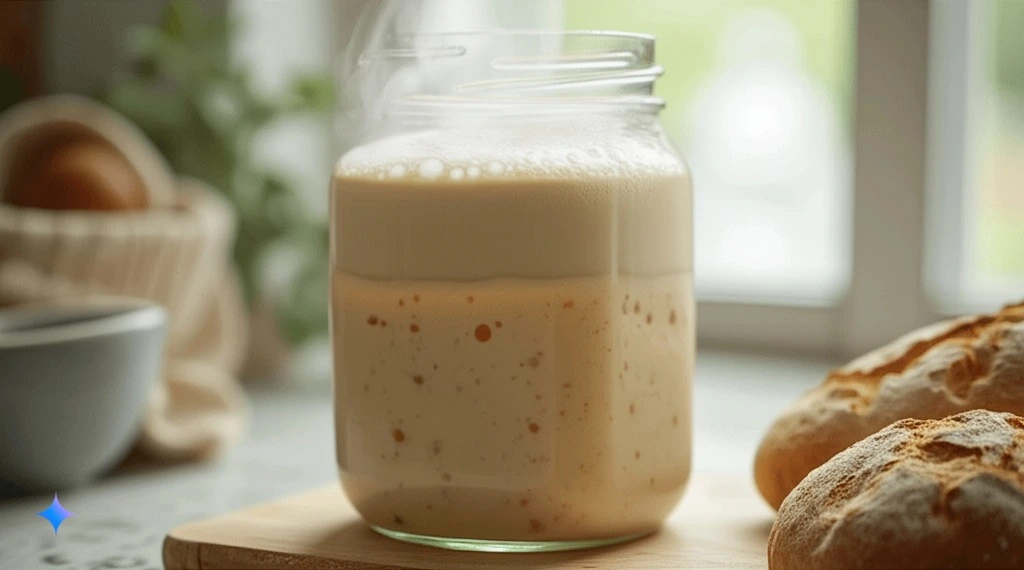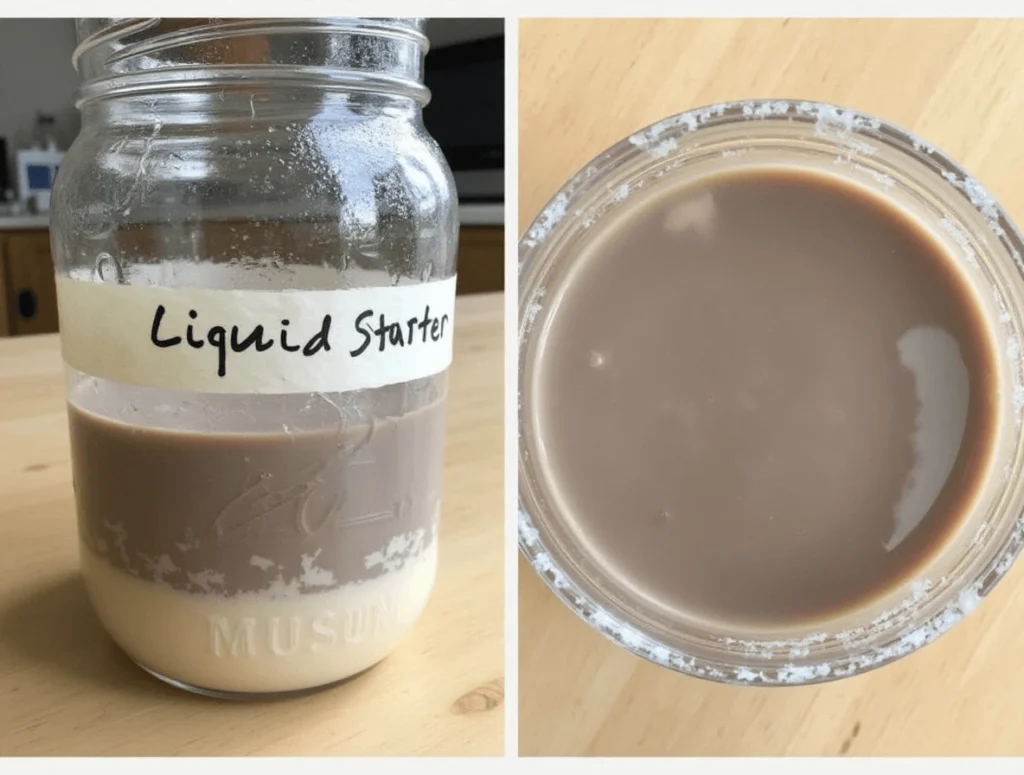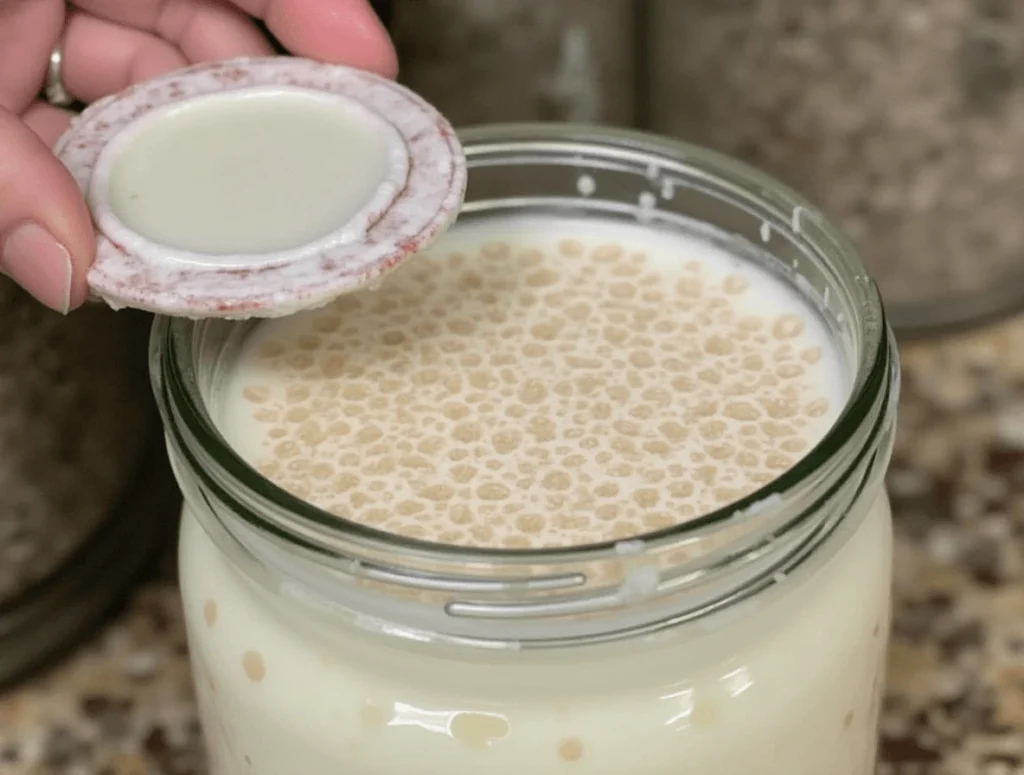How to Fix Your Sourdough Starter Smell Like Acetone

Uh oh, does the sourdough starter smell like acetone nail polish remover? Don’t panic! While it’s not the aroma of a perfectly proofed loaf, it’s a common issue with a fixable cause.
We’ve all been there. That acetone smell can be alarming, but it doesn’t necessarily mean your starter is ruined. The acetone smell is a sign of imbalance within your starter’s microbial ecosystem. This article will walk you through the causes and, more importantly, how to fix it.
Table of Contents
By the end of this article, you’ll understand why your sourdough starter smells like acetone and have a clear plan to get it back on track. You’ll learn both quick fixes and develop a deeper understanding of your starter’s needs.
Why Does My Sourdough Starter Smell Like Acetone?
Your sourdough starter is essentially a tiny ecosystem of wild yeasts and beneficial bacteria living in harmony. Think of it as a bustling microbial city where different organisms work together. When this ecosystem becomes imbalanced, problems like the acetone smell can develop.
The Microbial Ecosystem
In a healthy sourdough starter, wild yeasts and lactic acid bacteria exist in a symbiotic relationship. The yeasts consume sugars from flour and produce carbon dioxide (which makes your bread rise) and alcohol. The bacteria consume different compounds and produce acids that give sourdough its characteristic tangy flavor.
How Ethyl Acetate Forms
When your sourdough starter smells like acetone, what you’re actually smelling is ethyl acetate. Here’s how it forms:
- When yeasts are stressed (usually from hunger), they begin producing excess alcohol.
- This alcohol can interact with acetic acid bacteria in your starter.
- The interaction produces ethyl acetate, which has that distinct nail polish remover smell.
For the scientifically curious, the chemical equation looks like this:
Ethanol (alcohol) + Acetic Acid → Ethyl Acetate + Water
C₂H₅OH + CH₃COOH → CH₃COOC₂H₅ + H₂O
Role of Acetic Acid
Acetic acid contributes to the vinegary smell often present alongside the acetone aroma. This acid is a natural byproduct of fermentation but becomes more concentrated when the starter is underfed. When acetic acid combines with the excess alcohol in your hungry starter, ethyl acetate forms more readily.
Factors Contributing to Imbalance
Several factors can throw off your starter’s balance and lead to that acetone smell:
Underfeeding/Infrequent Feeding
When your starter doesn’t get fresh flour regularly, the yeasts consume all available sugars and begin to starve. This starvation triggers stress responses, including the production of more alcohol, leading to ethyl acetate formation.
Temperature Fluctuations
Different microbes thrive at different temperatures:
- Below 65°F (18°C): Fermentation slows dramatically
- 65-70°F (18-21°C): Acetic acid bacteria become more active (more vinegary)
- 70-85°F (21-29°C): Balanced activity (ideal range)
- Above 85°F (29°C): Lactic acid bacteria dominate (milder flavor)
In warmer climates, starters ferment faster and need more frequent feeding. In colder climates, fermentation slows, but extended periods without feeding can still lead to imbalance.
Incorrect Hydration
The water-to-flour ratio affects which microorganisms thrive:
- Stiff starters (lower hydration): Favor yeast growth
- Liquid starters (higher hydration): Favor bacterial activity
An improperly hydrated starter can develop imbalances between yeast and bacteria populations.
Flour Type
Different flours provide different nutrients:
- All-purpose flour: Lower in nutrients and enzymes
- Bread flour: Higher protein content supports stronger fermentation
- Whole wheat/rye: Rich in minerals and enzymes that accelerate fermentation
Using nutrient-poor flour can lead to microbial imbalances.
Starter Age
Young starters (less than 2 weeks old) haven’t established stable microbial communities yet, making them more susceptible to imbalances and off smells.
Inoculation Rate
This refers to how much mature starter you keep when feeding. A smaller amount of mature starter relative to fresh flour (like 1:5:5 starter:flour:water) gives the yeasts more food and time to consume it before hunger sets in.
How to Fix a Sourdough Starter Smelling Like Acetone
Before jumping into solutions, ask yourself these diagnostic questions to identify the root cause:

- When did you last feed your starter? (More than 24 hours ago suggests underfeeding.)
- What’s the ambient temperature? (Higher temperatures speed fermentation.)
- What consistency is your starter? (Too thick or too thin indicates hydration issues.)
- What type of flour are you using? (Refined flours provide fewer nutrients.)
Feeding Adjustments
| Issue | Solution |
|---|---|
| Infrequent feeding | Feed twice daily for 3 days (morning and evening) |
| Poor feeding ratio | Use 1:2:2 or 1:3:3 ratio (starter:flour:water by weight) |
| Weak fermentation | Try 1:1:1 ratio for stronger starters or 1:5:5 for very hungry ones |
Recommended Feeding Schedule for Recovery:
- Discard all but 25g of your starter
- Add 50g flour and 50g water (adjust quantities proportionally if needed)
- Mix thoroughly and let sit at room temperature
- Repeat every 12 hours for 3 days
Pro Tip: During recovery, whole wheat or rye flour (even just 10-20% of your total flour) can jump-start fermentation due to their higher nutrient content.
Temperature Control
Maintain your starter in the ideal temperature range of 70-75°F (21-24°C) during the recovery period.
For hot climates (above 80°F/27°C):
- Use cooler water when feeding
- Feed more frequently (every 8-10 hours)
- Store in the coolest part of your home
For cold climates (below 65°F/18°C):
- Use slightly warm water when feeding
- Place starter near (not on) a heat source
- Use an insulated container
Hydration Adjustments
If your starter seems:
- Too thick: Add a bit more water during feeding (aim for pancake batter consistency)
- Too thin: Add slightly more flour at next feeding
The Discard Method
For a quick fix, try this aggressive approach:
- Keep only a tiny amount (10g) of your starter
- Feed with 50g flour and 50g water
- This gives your microbes plenty of fresh food and dilutes the problematic compounds
Patience Is Key
Remember: fixing the acetone smell isn’t instantaneous. It may take 3-5 feeding cycles to fully restore balance. Watch for these signs of improvement:
- Increased bubbling and activity
- Return to a pleasantly sour aroma
- Consistent doubling in size after feeding
Preventing the Acetone Smell: Maintaining a Healthy Sourdough Starter
Prevention is easier than fixing problems! Follow these maintenance practices:

Regular Feeding Schedule
Establish a consistent routine based on your baking frequency:
- Active baking (multiple times weekly): Keep at room temperature, feed daily
- Occasional baking (weekly): Store in refrigerator, feed weekly
- Infrequent baking: Store in refrigerator, feed every 7-10 days
Temperature Monitoring
Use a simple kitchen thermometer to check ambient temperature. Adjust feeding frequency accordingly during seasonal changes.
Proper Hydration
Maintain a consistent texture—aim for thick pancake batter consistency for versatility.
Flour Quality
Use unbleached flour with some whole grain components for best results:
- 80% bread flour + 20% whole wheat is an excellent everyday mix
- All-purpose flour works, but may need more frequent feeding
Observation
Get to know your starter’s normal appearance, smell, and behavior. Early intervention prevents major issues.
Long-Term Care Tips
- For travel: Feed just before departure, then refrigerate
- For extended breaks: Create a stiff starter (less water) and refrigerate
- For very long storage: Dehydrate your starter on parchment paper
When to Worry (and When to Toss)
An acetone smell alone is rarely cause for discarding your starter. However, these signs indicate serious problems:
Warning Signs:
- Mold growth: Pink, orange, blue, or fuzzy growth on surface
- Unusual colors: Pink or orange tints in the starter itself
- Foul odors: Truly putrid smells (not just sour or acetone-like)
- Signs of infestation: Visible insects or larvae
If you only have an acetone smell with no visual problems, your starter is almost certainly salvageable with the methods described above.
Frequently Asked Questions
Can I still bake with my starter if it smells like acetone?
You can, but your bread may have off-flavors and reduced rise. It’s better to refresh it through 2-3 feeding cycles first.
How long will it take for the acetone smell to go away?
With consistent feeding, expect improvement within 2-3 days and complete resolution within 5-7 days.
Is the acetone smell harmful?
No, ethyl acetate (the compound causing the smell) is not harmful in these small amounts. It’s a natural byproduct of fermentation.
What’s the difference between a healthy smell and an acetone smell?
A healthy sourdough starter smells pleasantly sour, yeasty, or even slightly fruity. The acetone smell is distinctly chemical, similar to nail polish remover.
Conclusion
Understanding why your sourdough starter smells like acetone is the first step to fixing it. Remember that this issue stems from an imbalanced microbial ecosystem, usually due to underfeeding, temperature fluctuations, or improper maintenance.
By following the recovery steps outlined in this guide and establishing good maintenance practices, you can restore your starter’s health and prevent future problems. The key is consistency, observation, and responding promptly to changes in your starter’s behavior.
Now that you understand why your starter smells like acetone and how to fix it, it’s time to get baking! Your revitalized starter will reward you with delicious, well-risen sourdough bread.






